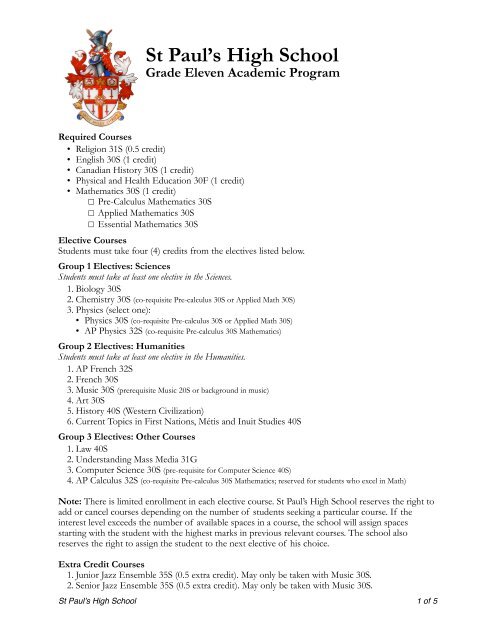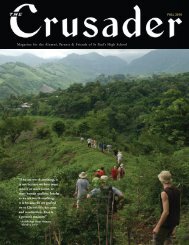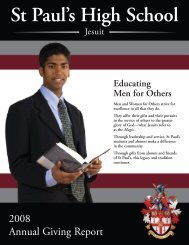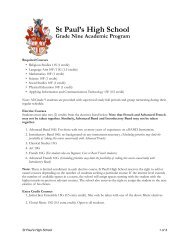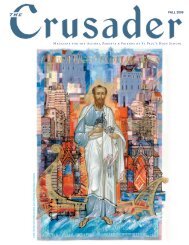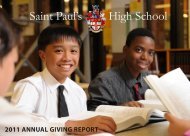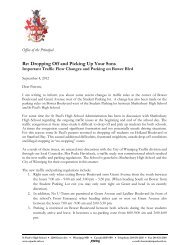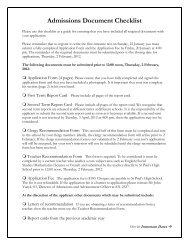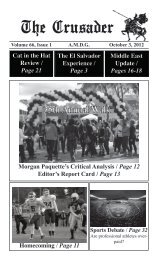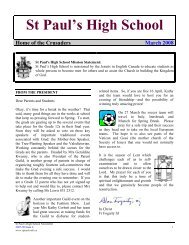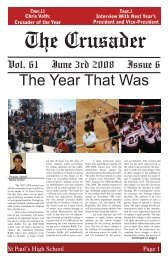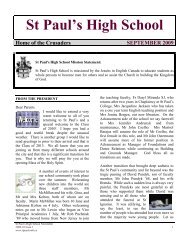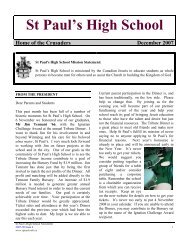Grade 11 Program - St Paul's High School
Grade 11 Program - St Paul's High School
Grade 11 Program - St Paul's High School
Create successful ePaper yourself
Turn your PDF publications into a flip-book with our unique Google optimized e-Paper software.
<strong>St</strong> Paul’s <strong>High</strong> <strong>School</strong><br />
<strong>Grade</strong> Eleven Academic <strong>Program</strong><br />
Required Courses<br />
• Religion 31S (0.5 credit)<br />
• English 30S (1 credit)<br />
• Canadian History 30S (1 credit)<br />
• Physical and Health Education 30F (1 credit)<br />
• Mathematics 30S (1 credit)<br />
☐ Pre-Calculus Mathematics 30S<br />
☐ Applied Mathematics 30S<br />
☐ Essential Mathematics 30S<br />
Elective Courses<br />
<strong>St</strong>udents must take four (4) credits from the electives listed below.<br />
Group 1 Electives: Sciences<br />
<strong>St</strong>udents must take at least one elective in the Sciences.<br />
1. Biology 30S<br />
2. Chemistry 30S (co-requisite Pre-calculus 30S or Applied Math 30S)<br />
3. Physics (select one):<br />
• Physics 30S (co-requisite Pre-calculus 30S or Applied Math 30S)<br />
• AP Physics 32S (co-requisite Pre-calculus 30S Mathematics)<br />
Group 2 Electives: Humanities<br />
<strong>St</strong>udents must take at least one elective in the Humanities.<br />
1. AP French 32S<br />
2. French 30S<br />
3. Music 30S (prerequisite Music 20S or background in music)<br />
4. Art 30S<br />
5. History 40S (Western Civilization)<br />
6. Current Topics in First Nations, Métis and Inuit <strong>St</strong>udies 40S<br />
Group 3 Electives: Other Courses<br />
1. Law 40S<br />
2. Understanding Mass Media 31G<br />
3. Computer Science 30S (pre-requisite for Computer Science 40S)<br />
4. AP Calculus 32S (co-requisite Pre-calculus 30S Mathematics; reserved for students who excel in Math)<br />
Note: There is limited enrollment in each elective course. <strong>St</strong> Paul’s <strong>High</strong> <strong>School</strong> reserves the right to<br />
add or cancel courses depending on the number of students seeking a particular course. If the<br />
interest level exceeds the number of available spaces in a course, the school will assign spaces<br />
starting with the student with the highest marks in previous relevant courses. The school also<br />
reserves the right to assign the student to the next elective of his choice.<br />
Extra Credit Courses<br />
1. Junior Jazz Ensemble 35S (0.5 extra credit). May only be taken with Music 30S.<br />
2. Senior Jazz Ensemble 35S (0.5 extra credit). May only be taken with Music 30S.<br />
<strong>St</strong> Paul’s <strong>High</strong> <strong>School</strong>! 1 of 5
Required Courses<br />
One of the following Math courses must be chosen.<br />
PRE-CALCULUS MATHEMATICS 30S<br />
Pre-Calculus Mathematics 30S is designed for students who intend to study calculus and related<br />
mathematics as part of their post-secondary education. The course comprises, primarily, a high-level<br />
study of theoretical mathematics with an emphasis on problem solving, mental mathematics, as well<br />
as cumulative exercises and testing. Many of the exercises and problems are expected to be original<br />
or different from those presented in class. Topics include quadratic functions, trigonometry, algebra,<br />
and reciprocal functions. The student is expected to work both individually and in small groups and<br />
must demonstrate a high level of mastery in algebraic operations, an aptitude for problem solving<br />
and an ability to effectively communicate both in verbal and in written format, the logical steps<br />
required to arrive at solution. It is recommended that students should have achieved a mark of 70%<br />
or more in Introduction to the Applied and Pre-Calculus Mathematics 20S course to ensure future<br />
success in this program of study. This course is a prerequisite for Pre-Calculus Mathematics 40S.<br />
APPLIED MATHEMATICS 30S<br />
This course is available for students planning to pursue post-secondary studies in mathematics and<br />
science. This course is an extension of the ideas and concepts presented in the Introduction to<br />
Applied and Pre-Calculus Mathematics 20S course, and builds a foundation for <strong>Grade</strong> 12 Applied<br />
Mathematics. The curriculum is particularly directed to students planning to enter areas that require<br />
a mathematics/technology based background. The course is data-driven. <strong>St</strong>udents collect data from<br />
a wide array of sources in a series of experiments and activities. The student develops mathematical<br />
concepts through the analysis of this data. Topics found in this course include: measurement,<br />
geometry, logical reasoning, statistics, and relations and functions. This course is a prerequisite for<br />
Applied Mathematics 40S.<br />
ESSENTIAL MATHEMATICS 30S<br />
This course is intended for students whose post-secondary planning does not include a focus on<br />
mathematics and science related fields. The Essential Mathematics program of study that will be<br />
completed with the 40S level is recognized by the universities as a mathematics elective for first year<br />
university entrance. This course builds on the knowledge and skills of <strong>Grade</strong> 10 Essential<br />
Mathematics and provides a foundation for the topics studied in <strong>Grade</strong> 12 Essential Mathematics.<br />
The course is structured into two half courses, each emphasizing communication, number sense,<br />
patterns, problem solving, reasoning, technology, visualization and connections. <strong>St</strong>udents are<br />
expected to work both individually and in small groups on mathematical concepts and skills<br />
encountered in a technological society. There is no pre-requisite for this course.<br />
Elective Courses<br />
Four of the following courses must be chosen.<br />
BIOLOGY 30S<br />
The Biology 30S program provides the student with an opportunity to learn some basic language,<br />
skills and knowledge of biology which is useful in Biology 40S and in higher levels of study at<br />
university or in an applied technology area. For example, the topics covered in Biology 30S are<br />
investigated in more detail in Introductory Biology making up 45% of the content of Bio 1020 and<br />
many topics in Bio 1030 at the University of Manitoba. In addition, the topics covered in Biology<br />
30S are preparatory for Zoology courses in Anatomy and Physiology which are required by faculties<br />
such as Physical Education and Medical Rehab etc. Although Biology 30S is not a formal<br />
prerequisite for Biology 40S it is STRONGLY RECOMMENDED. Only students who successfully<br />
complete Biology 30S or who have demonstrated an aptitude for Science or who have high averages<br />
will be accepted into Biology 40S. The students will study human biology using a “systems”<br />
<strong>St</strong> Paul’s <strong>High</strong> <strong>School</strong>! 2 of 5
approach. Course topics include the following: cell structure and function, biochemistry, metabolism<br />
and energy, an introduction to anatomy, digestion and nutrition, the heart and circulatory system, the<br />
respiratory system, the lymphatic, immune and endocrine system and the nervous system. There is<br />
an extensive lab program involving dissection and microscope techniques. <strong>St</strong>udents will be required<br />
to keep a lab journal and will be required to write research papers. The dissection of a preserved<br />
specimen will be in the second term.<br />
CHEMISTRY 30S<br />
Chemistry is the study of the structure and interaction of substances. Chemistry 30S provides the<br />
student with an introduction to the basic language and fundamental skills required to study<br />
chemistry at a higher level. While students began studying Chemistry in Science 10F and 20F, this<br />
course will go into much more detail and introduce new topics. Some topics covered are atomic<br />
structure, gases, solubility, different types of solutions, chemical reactions and quantitative<br />
calculations based on these. Organic chemistry will be introduced through a systemic organization<br />
based on alkanes, alkenes, alkynes, aromatic compounds, alcohols, organic acids, esters and other<br />
substituted derivatives. In the lab program students will learn basic laboratory skills with experiments<br />
that relate to the topics developed in the classroom. The prerequisite for this course is Science 20F.<br />
A reasonably strong mathematical aptitude is required because of the large amount of problem<br />
solving done.<br />
PHYSICS 30S<br />
Physics deals with the relationship between matter and energy. Physics 30S builds on the Physics<br />
component of the Science 20F program. It provides the student with the ability to describe the<br />
natural world around him both theoretically and mathematically. Areas of study include vector<br />
analysis, kinematics, mechanics, fields (gravitational, electrostatic and magnetic) and waves (sound,<br />
water and light). Tools such as graphical analysis, vectors and problem solving are used throughout.<br />
An emphasis is placed on lab work and practical applications of the material. This course is a<br />
prerequisite for Physics 40S. It requires a high level of problem solving and calculation. <strong>St</strong>udents<br />
must have demonstrated good skills in prior Science 20F and Mathematics 20S courses. (A minimum<br />
average of 60 % in these subjects is required and a minimum average of 65% in Physics component<br />
of Science 20F is recommended.)<br />
AP PHYSICS 32S<br />
The AP Physics B course is an advanced physics curriculum that follows the Manitoba curriculum<br />
for <strong>Grade</strong> Eleven Physics but is supplemented with a number of topics from the <strong>Grade</strong> Twelve<br />
program including 2-D Vector Analysis, Projectiles, 2-D Momentum, Work and Energy. The AP<br />
Physics B program, while non-Calculus based, requires a very high level of Mathematical skill. This<br />
course should be considered as the beginning of a two-year program although students may opt for<br />
the regular 40S Physics program, after Year 1. A maximum of 24 students who have excelled in both<br />
Science 20F and Math Pre Calculus 20S will be accepted into this course. <strong>St</strong>udents may not take<br />
Physics 30S and AP Physics 32S concurrently. If there are insufficient numbers opting for this<br />
course the school reserves the right to cancel the option and place students in Physics 30S. In the<br />
event a student requesting this course is not admitted into AP Physics, he will automatically be<br />
enrolled in Physics 30S.<br />
FRENCH 30S<br />
The prerequisite for this course is <strong>Grade</strong> Ten French or the approval of the Department Head. This<br />
course deals primarily with mastery of two basic skills: speaking and comprehension. The emphasis<br />
will be on everyday teenage conversations. <strong>St</strong>udents will be invited to improve their proficiency in<br />
French by participating actively in classroom discussions, by preparing and improvising skits in small<br />
groups, and by working with interactive software in the Language Lab. Testing will focus primarily<br />
on oral examinations.<br />
<strong>St</strong> Paul’s <strong>High</strong> <strong>School</strong>! 3 of 5
AP FRENCH 32S<br />
Le cours de français dixième année est pré-requis ou la permission du chef de département est<br />
requise. Ce cours est axé sur l’expression orale. Il vise à approfondir les connaissances linguistiques<br />
des élèves à travers l’étude de documents authentiques. Les élèves seront appelés à visionner<br />
plusieurs bulletins d’informations et quelques films; à faire des recherches sur Internet, à profiter des<br />
logiciels qui leur sont disponibles au laboratoire de langues, à lire diverses publications en vue de<br />
préparer un débat sur un sujet controversé, à monter quelques saynètes à partir du vocabulaire<br />
nouvellement acquis et à participer activement aux nombreuses discussions en classe. Ils auront à<br />
améliorer leur français écrit également en maîtrisant les concepts grammaticaux suggérés par le<br />
curriculum du Ministère et en faisant appel à la composition et à la dictée.<br />
MUSIC 30S & 35S<br />
In <strong>Grade</strong> Eleven there are three music classes available: Symphonic Band (30S), Jr. Jazz Ensemble<br />
(35G) and Sr. Jazz Ensemble (35G).<br />
Symphonic Band 30S<br />
The prerequisite is good standing in <strong>Grade</strong> Ten music or the ability to demonstrate a comparable<br />
playing level on a band instrument. This is a performance-focused course that will continue the<br />
development of each student’s musical skills and understanding through the playing of their<br />
instrument. The course also includes the study of music theory and music history.<br />
Music 35S (0.5 extra credit)<br />
Jr. Jazz Ensemble is an introductory level half-credit course in jazz music that is open to music<br />
students from <strong>Grade</strong>s 9–12. Jr. Jazz ensemble is an option to all <strong>St</strong> Paul’s music students that play an<br />
instrument that is part of the jazz ensemble. Auditions will only take place in the case that there are<br />
more students on a particular instrument than there are spots available. Mr. Gardner endeavors to<br />
include as many students as possible in Jr. Jazz Ensemble. Auditions if required take place in<br />
September. Jr. Jazz Ensemble meets two mornings per week outside of the regular schedule.<br />
Sr. Jazz Ensemble is an advanced level half-credit course in jazz music that is open to music<br />
students from <strong>Grade</strong>s 10-12. The course is performance focused. Auditions will only take place in<br />
the case that there are more students on a particular instrument than there are spots available. Mr.<br />
Gardner endeavors to include as many students as possible in Sr. Jazz Ensemble. Auditions if<br />
required take place in April prior to the upcoming school year.<br />
No previous jazz experience is required for Jr. Jazz Ensemble. Good standing in Jr. Jazz Ensemble is<br />
a prerequisite for Sr. Jazz Ensemble. It is expected that students who wish to take either jazz<br />
ensemble must be enrolled in the Concert Band <strong>Program</strong>.<br />
ART 30S<br />
<strong>Grade</strong> Eleven Art will deal with all of the skills in drawing, design and analysis that have been dealt<br />
with in <strong>Grade</strong> Nine and <strong>Grade</strong> Ten Art. Rather than a rigid adherence to one outline of study,<br />
however, there will be more of an opportunity for students choose their own particular area of<br />
expertise. The Art History and Theory part of the course will be continued, with a particular focus<br />
on Twentieth Century Art. Only one section of Art will be offered in <strong>Grade</strong> <strong>11</strong> and enrollment is<br />
limited. Credits in <strong>Grade</strong> Nine and <strong>Grade</strong> Ten Art are useful, but not essential. Priority will be given<br />
to students who have completed <strong>Grade</strong> 10 Art and who have demonstrated a commitment to<br />
developing their skills both in class and through completion of take home sketchbook assignments.<br />
<strong>St</strong> Paul’s <strong>High</strong> <strong>School</strong>! 4 of 5
HISTORY: WESTERN CIVILIZATION 40S<br />
This course covers the history of western civilization, beginning with the ancient Greeks and ending<br />
with the present day. The areas to be considered will be Greek and Roman societies, the Medieval<br />
world, the Renaissance and Reformation, the rise of absolute monarchies, revolutions, and reactions,<br />
the growth of nationalism, World Wars I and II. The course is designed to stimulate discussion and<br />
to develop in students a deeper understanding of our culture’s roots and traditions.<br />
LAW 40S<br />
This course is intended to increase students’ awareness and appreciation of the laws that govern and<br />
protect society. The first term will deal mainly with criminal law and will follow the justice system as<br />
to how it deals with items such as search laws, arrests, defences, evidence, jury selection and<br />
sentencing. The second term will deal with contract law, tort and family law. A field trip to the Law<br />
Courts building is planned. This course can be used for your University of Manitoba entrance<br />
average BUT is NOT USED in the University of Manitoba scholarship calculations.<br />
CURRENT TOPICS IN FIRST NATIONS, MÉTIS, AND INUIT STUDIES 40S<br />
This course examines Indigenous realities within contemporary and historical settings. The course is<br />
inclusive of the traditional values and worldviews of First Nations, Metis and Inuit peoples. The<br />
objective is to provide both Indigenous and non-Indigenous students with knowledge of Indigenous<br />
cultures and traditions. Topics to be covered include: Image and Identity, Relations with<br />
Government, Social Justice Issues, and Indigenous Peoples and the World.<br />
MEDIA 31G: FILM STUDIES<br />
Media 31G is an introduction to the study of film. It is intended that students will come to see film<br />
as not only a source of entertainment, but as a communication medium and an emotive medium<br />
that stimulates personal and individual interpretations as well. An emphasis will be placed on the<br />
history of film and an analysis of a variety of film genres. There is no prerequisite.<br />
COMPUTER SCIENCE 30S<br />
This is a first course in Computer Science. <strong>St</strong>udents will learn to program computers using the C++<br />
programming language as a problem-solving tool. The course also contains the study of the<br />
fundamental algorithms of computer programming. <strong>St</strong>udents will study the binary nature of the<br />
computer by examining the internal structure of data and designing Boolean circuits. Other topics<br />
to be included in the course are: recent advances in computer hardware and software, ethical use of<br />
computers in society, and career opportunities in information technology.<br />
AP CALCULUS 32S<br />
This full credit course is a prerequisite for the AP Calculus 42S course offered at the <strong>Grade</strong> 12 level.<br />
<strong>St</strong>udents who have successfully completed the Introduction to Applied and Pre-Calculus<br />
Mathematics 20S course with a minimum mark of 80% and are planning on a career in engineering<br />
or any other mathematics related field of post-secondary study should consider this option. The AP<br />
Calculus 32S course is divided into two areas of studies: Calculus and Advanced Topics. In the<br />
Calculus unit, topics include: Limits of a Function, Limits and Continuity, Definition for a<br />
Derivative, Rules for Differentiation, Chain Rule, Implicit Differentiation, and Related Rates. In the<br />
Advanced Topics section, topics include: Linear Algebra and Matrices, Mathematical Induction, and<br />
Complex Numbers. In addition to these topics, students will also complete preparatory work for the<br />
Canadian Mathematics Competitions (Fermat) held in February of each year.<br />
<strong>St</strong> Paul’s <strong>High</strong> <strong>School</strong>! 5 of 5


